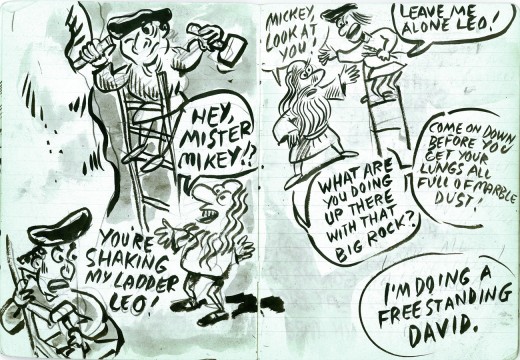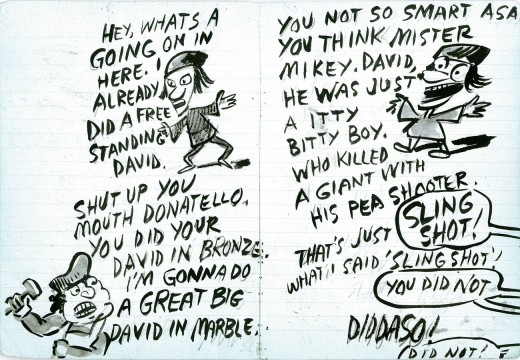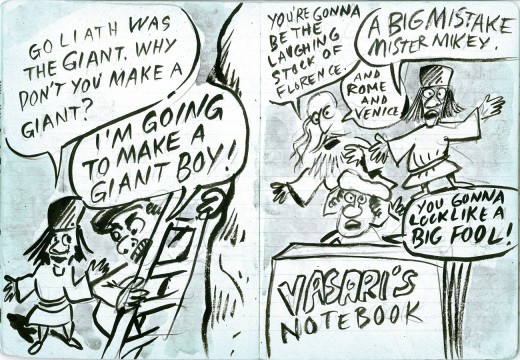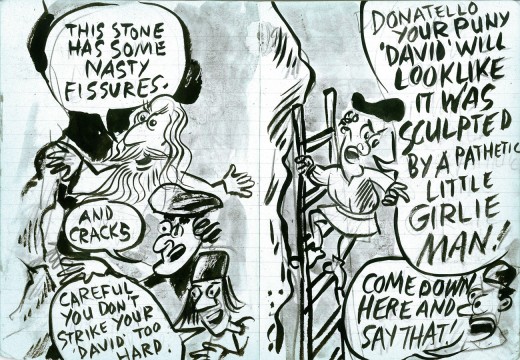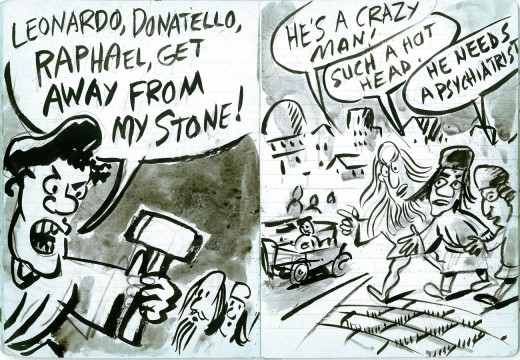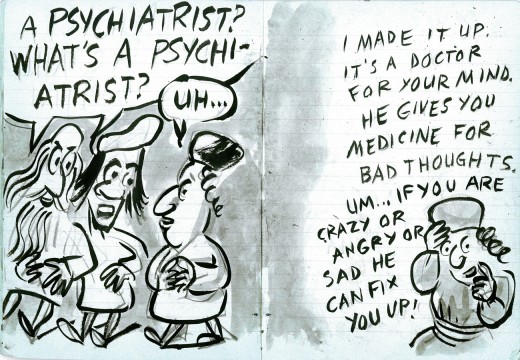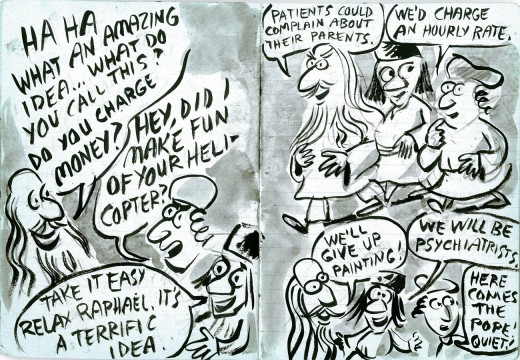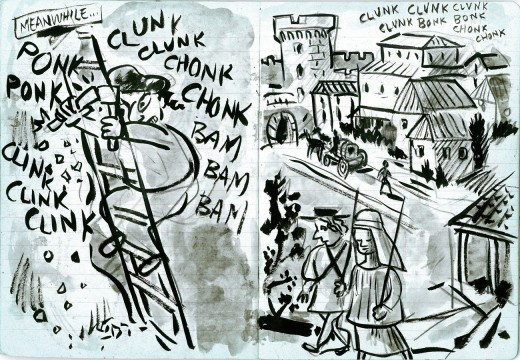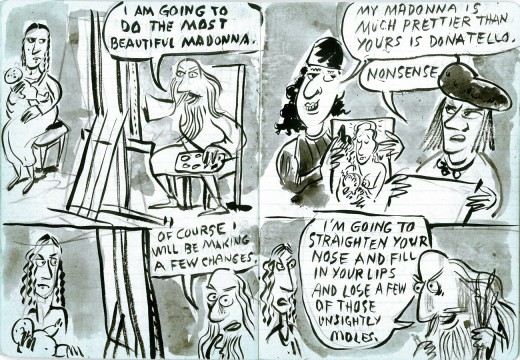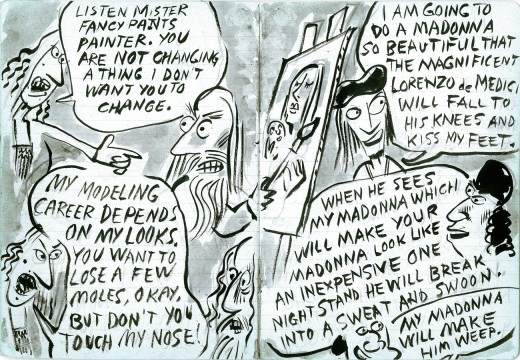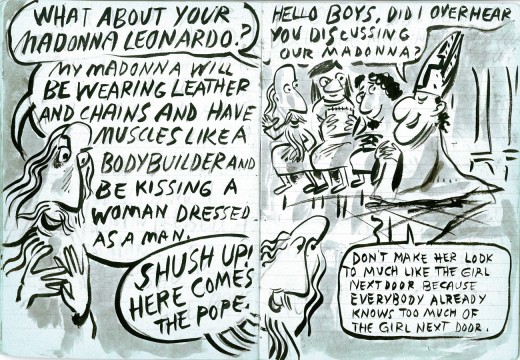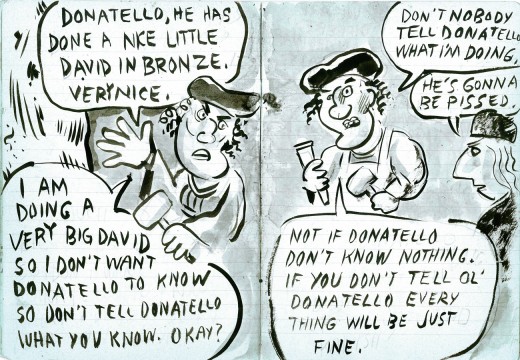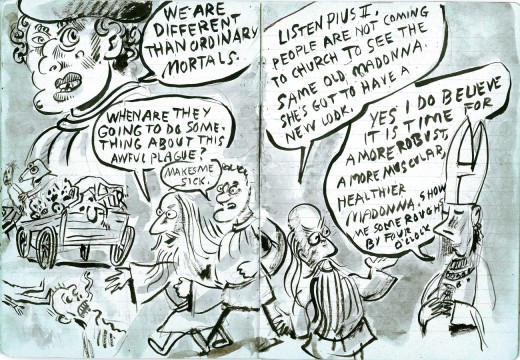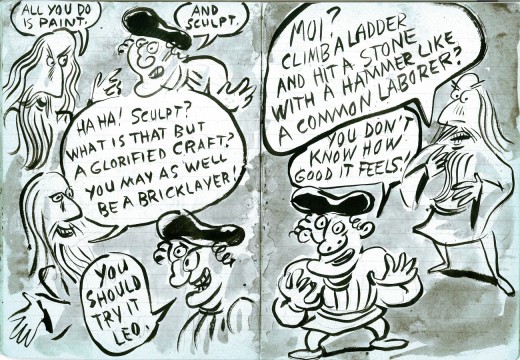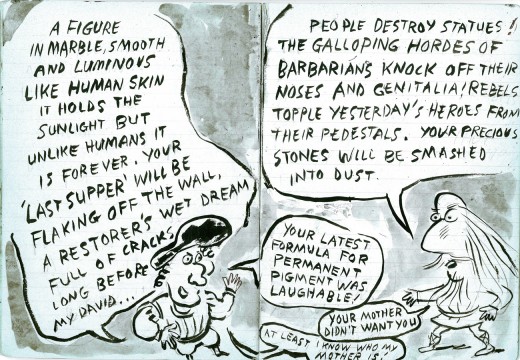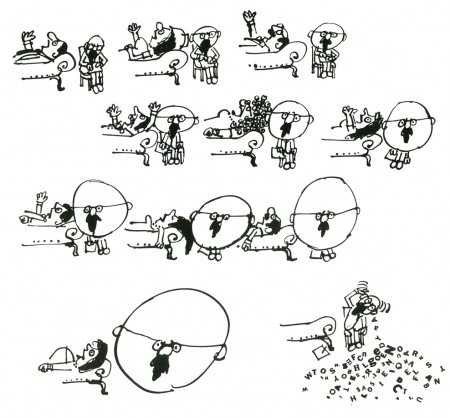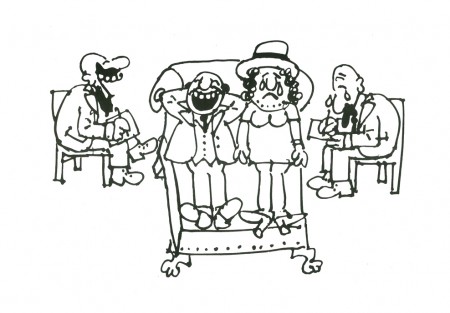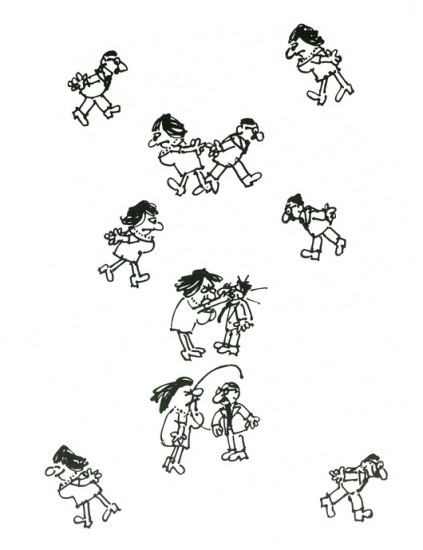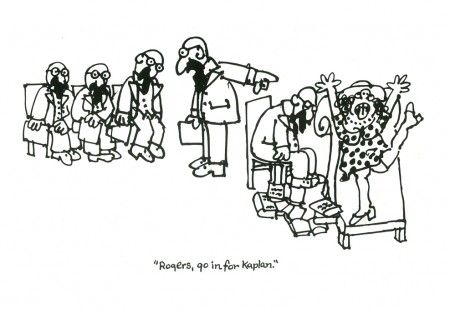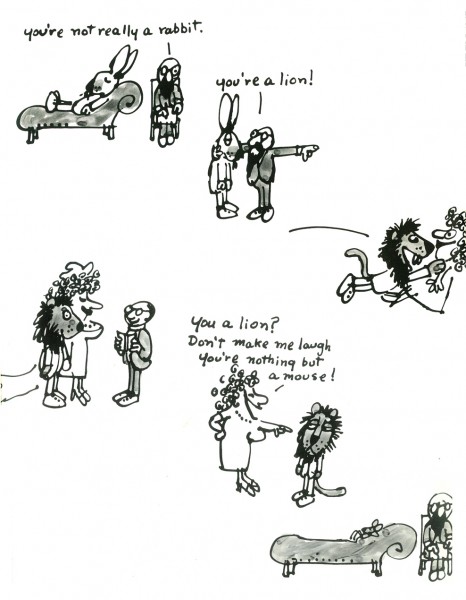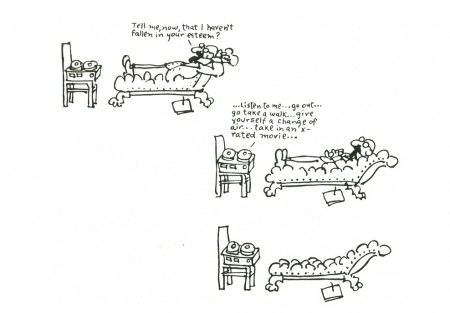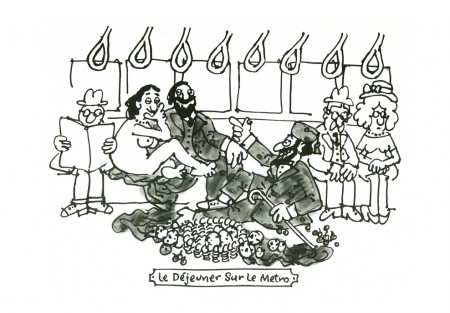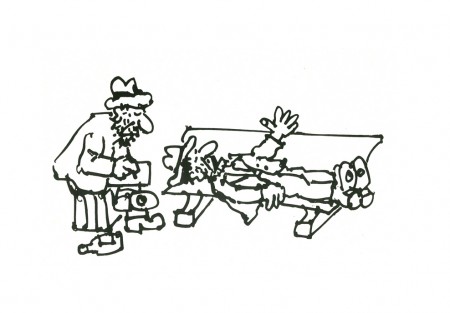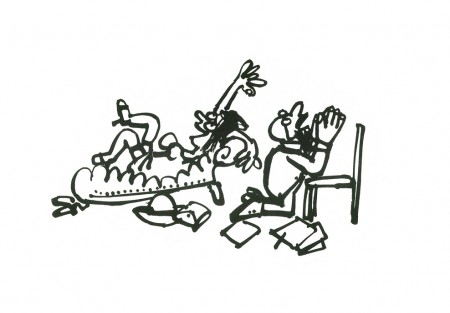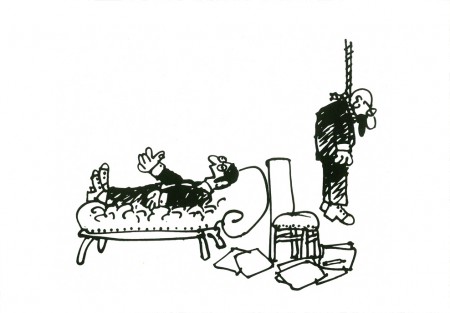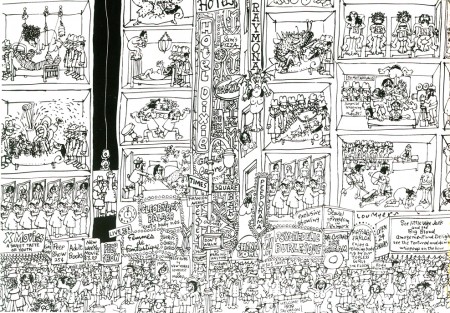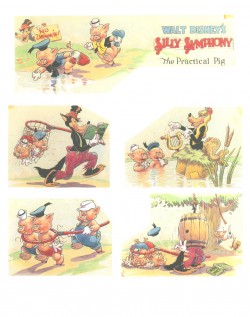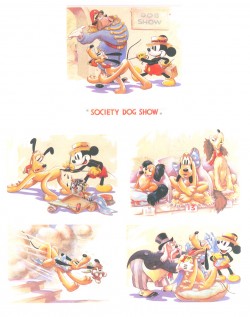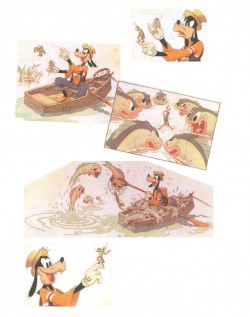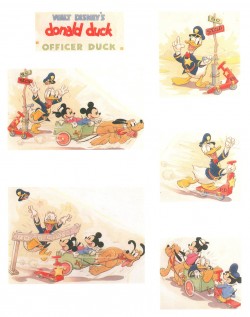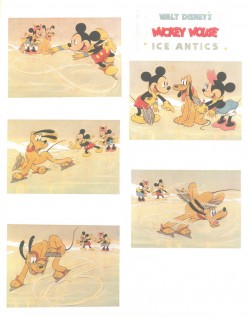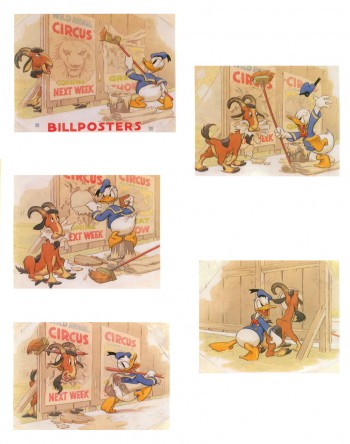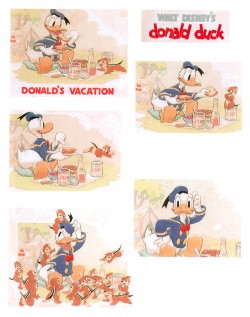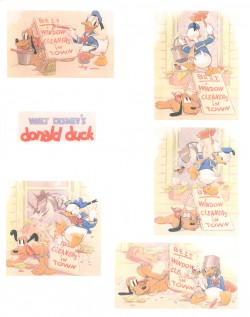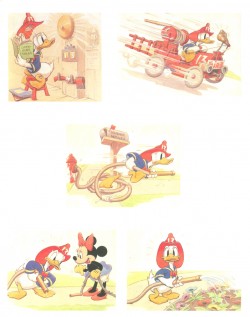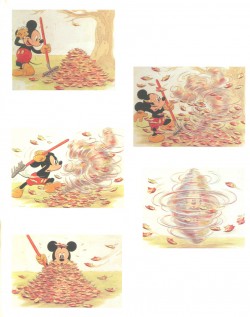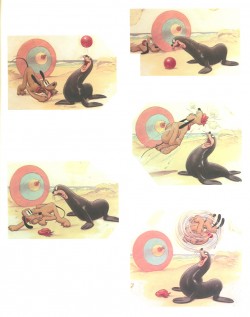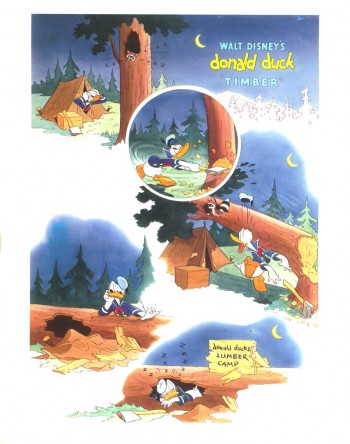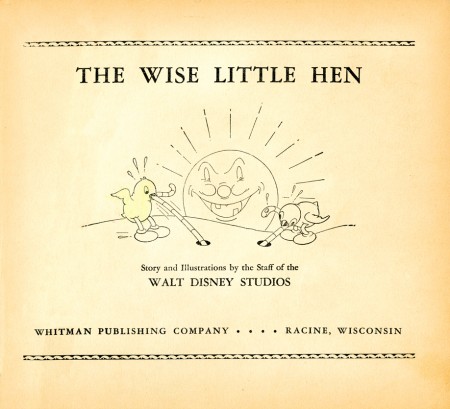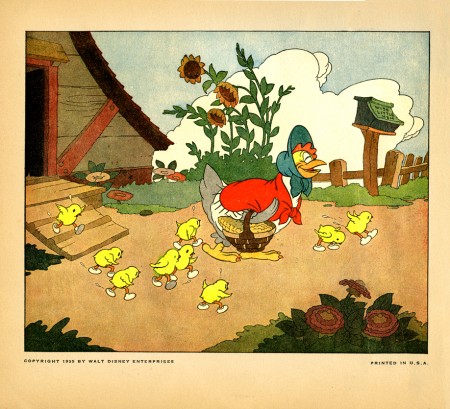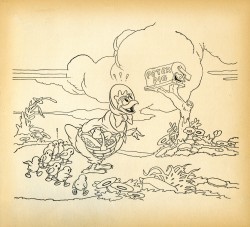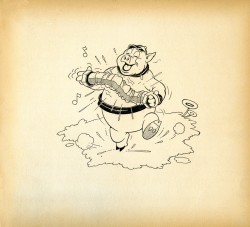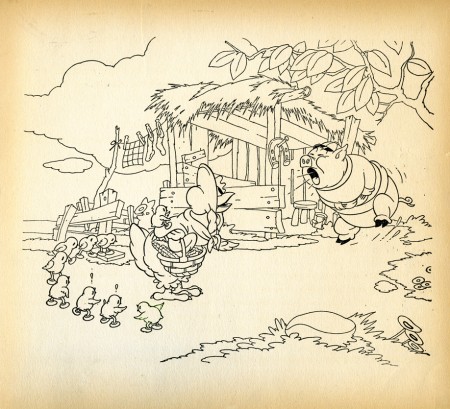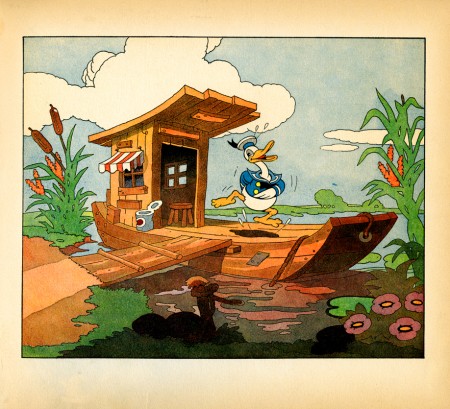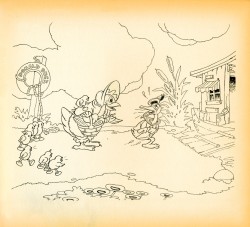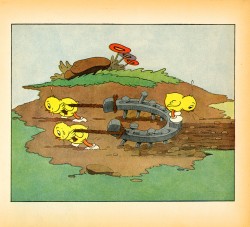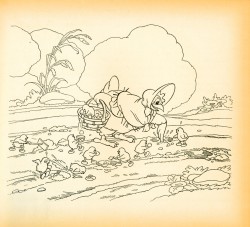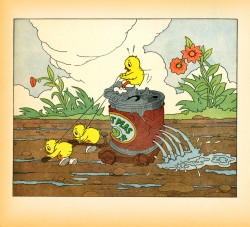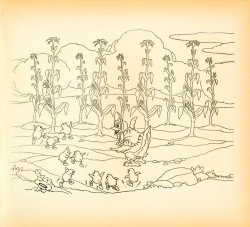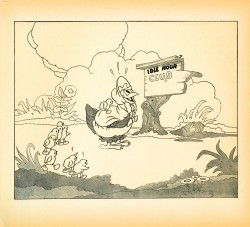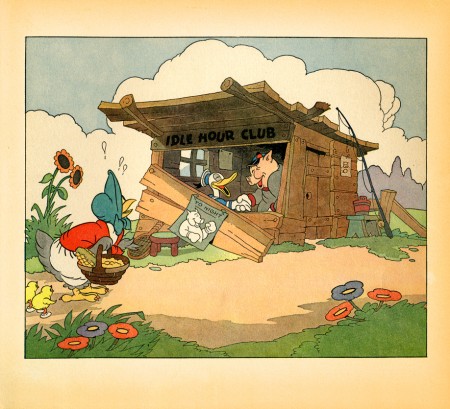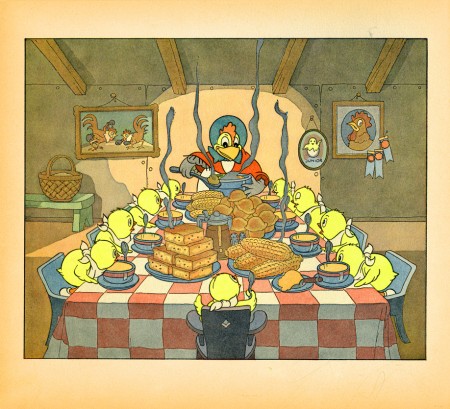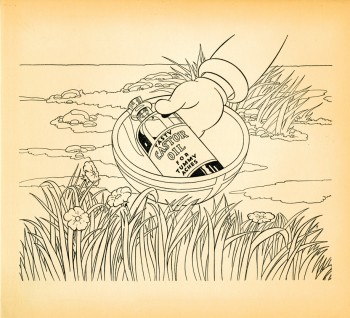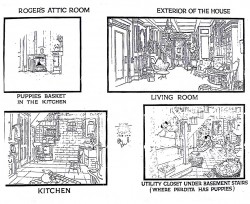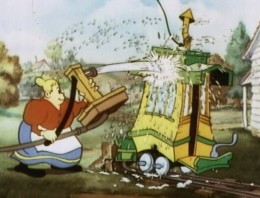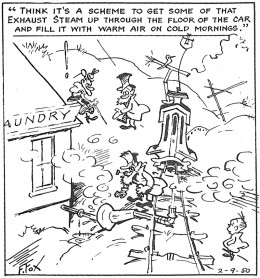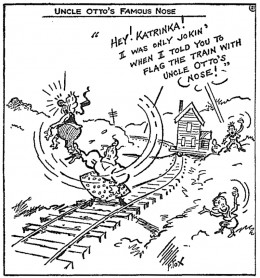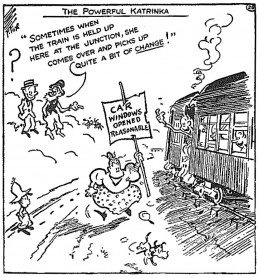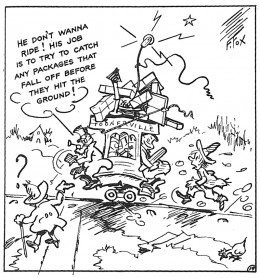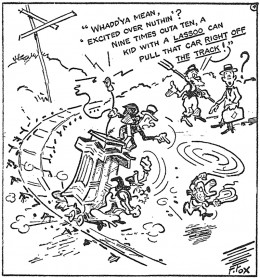Category ArchiveComic Art
Comic Art &T.Hachtman 14 Nov 2009 09:02 am
Renaissance Masters 3
 - I saw The Fantastic Mr. Fox last night. It is fantastic; I loved it. The actors, of course, were all superb, and the klunky animation works well with the master plan Wes Anderson brought to it. This is a good example of what one strong-minded director can bring to an animated film (feature or short). The feature deserves all the excellently positive reviews it’s getting.
- I saw The Fantastic Mr. Fox last night. It is fantastic; I loved it. The actors, of course, were all superb, and the klunky animation works well with the master plan Wes Anderson brought to it. This is a good example of what one strong-minded director can bring to an animated film (feature or short). The feature deserves all the excellently positive reviews it’s getting.
- It’s Saturday, and here’s part 3 of Tom Hachtman ‘s previously unpublished strip, Renaissance Masters. He drew this in a green-covered paper notebook with blue lines on every page. There’s no doubt it should have been published somewhere, and I’m glad to oblige as best I can.
Here’re the links to Part 1 and Part 2 if you want to read previously posted cartoons.
To get you back up to speed, I’ll start with the final pages of last week’s entry. Enjoy.
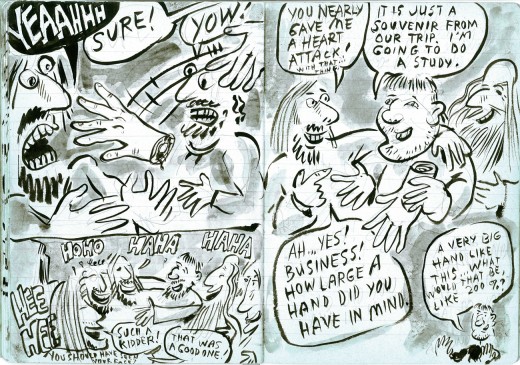 35
35Click any image to enlarge.)
.
 36
36.
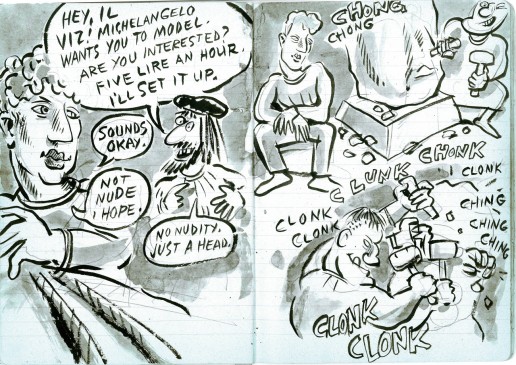 37
37.
 38
38.
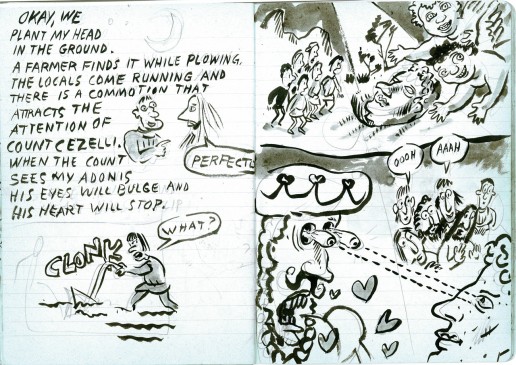 39
39.
 40
40.
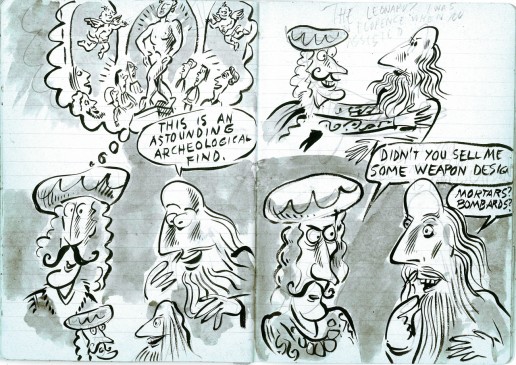 41
41.
 42
42.
 43
43.
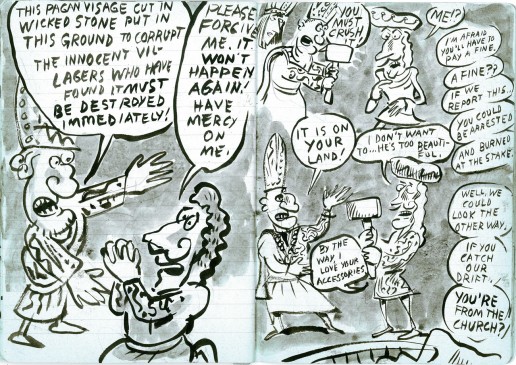 44
44.
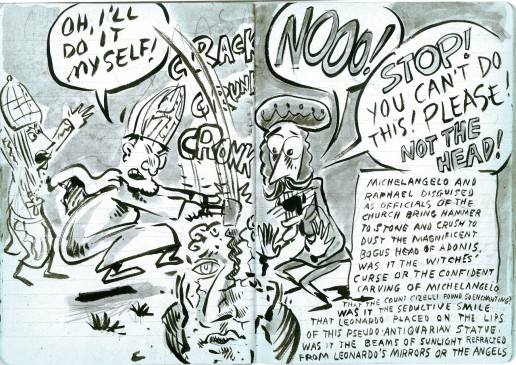 45
45The final installment will come next Saturday.
Comic Art &Illustration &T.Hachtman 07 Nov 2009 08:49 am
Renaissance Masters 2
- It’s Saturday, so it’s time to continue with Tom Hachtman’s strip, Renaissance Masters. We started posting this last Saturday; (go here to see Part 1.)
 18
18(Click any image to enlarge.)
.
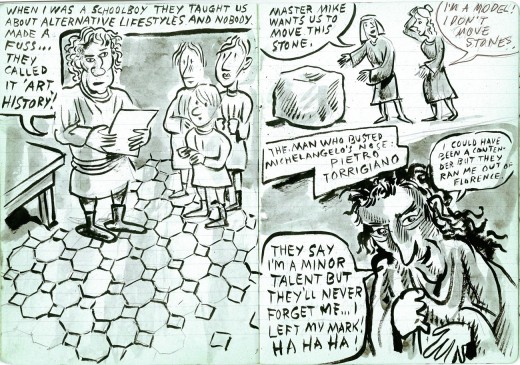 19
19.
 20
20.
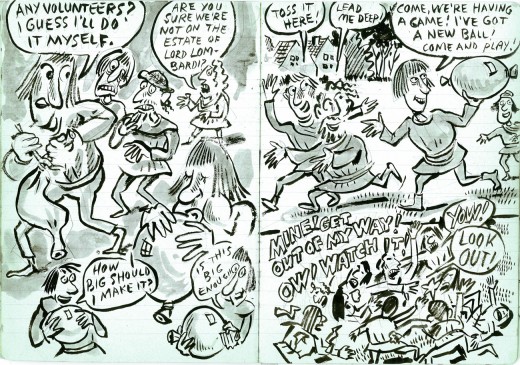 21
21.
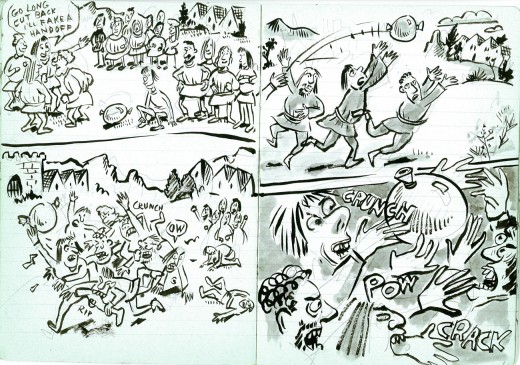 22
22.
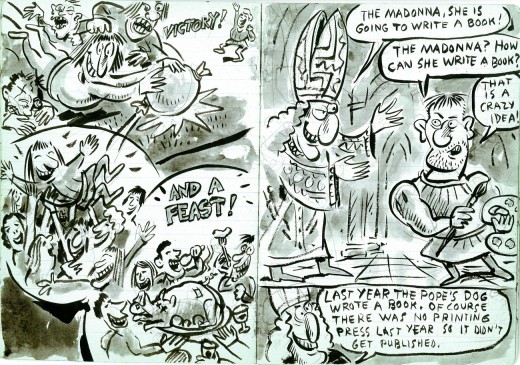 23
23.
 24
24.
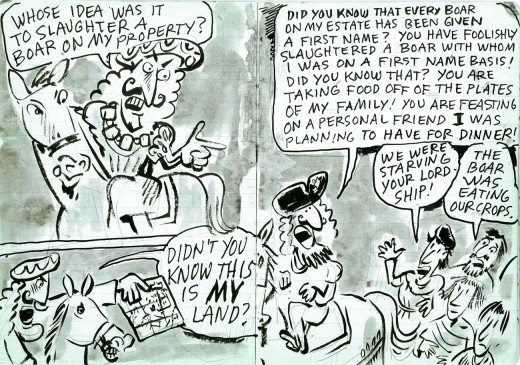 25
25.
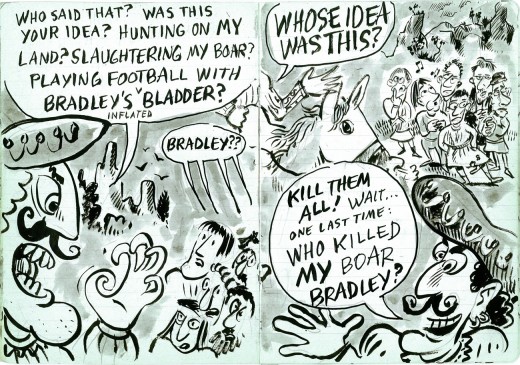 26
26.
 27
27.
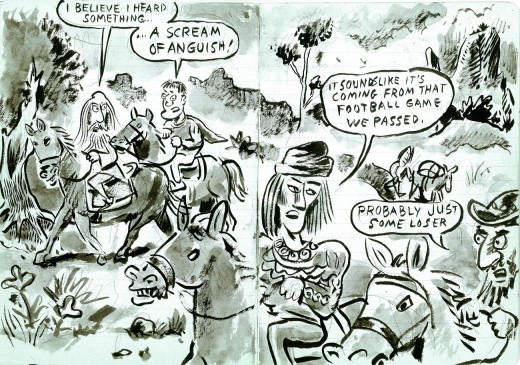 28
28.
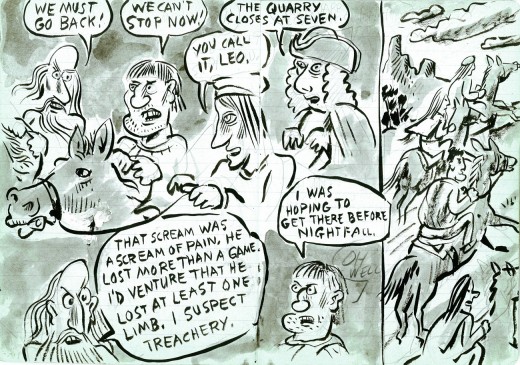 29
29.
 30
30.
 31
31.
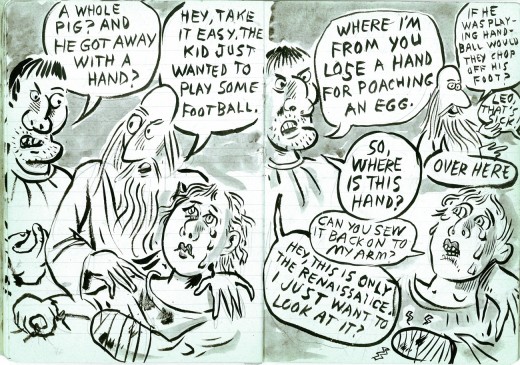 32
32.
 33
33.
 34
34.
 35
35.
More next Saturday. Thanks, Tom Hachtman, for sharing.
Comic Art &T.Hachtman 31 Oct 2009 07:35 am
Renaissance Masters 1
- Tom Hachtman, you’ll remember, is the cartoonist whose comic strip, Gertrude’s Follies, featured characters out the Americans and artists in Paris: Gertrude Stein, Pablo Picasso, Ernest Hemingway and others during the 20s – but set in modern day. The strip was a success, and I made a short or two out of it, trying to get interest in a feature.
Tom actually started to develop another strip. With this one he mined the Renaissance Masters, and that’s what he called the strip. Michelangelo, Leonardo, Raphael and all the other biggies are in there.
He did this strip in a notebook (with blue lines), and he gave me the book to post on this site – at my request, of course. So for the next few weeks, I’ll post all the double page panels done with India Ink and wash. At a good breaking point we’ll continue it next week.
Here they are, the Renaissance Masters:
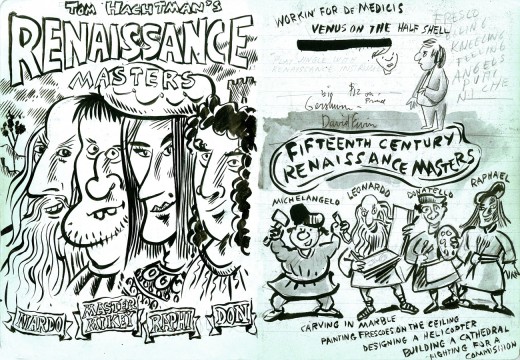 1
1(Click any image to enlarge.)
Books &Comic Art 17 Oct 2009 09:09 am
Lou Myers
- I’ve been a fan of the panel cartoonist, Lou Myers, for ever. His work makes me laugh. His drawing style looks like art to me, and that makes me laugh, too. He has a numbner of books on the market that collect his cartoons.
His book, Absent & Accounted For, is a good sampling of his work. I pulled it off my shelf last week and it got me laughing. So I thought I’d give you a few of the cartoons in the book. It’s a gem, published in 1980. Lots of therapists and sex jokes. Here are some of the therapy gags.
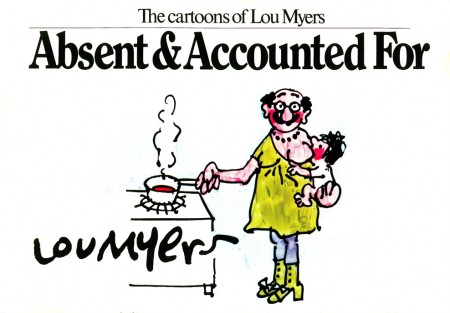
(Click any image to enlarge.)
Some of Lou Myers other books include:
When Life Falls It Falls Upside Down, Christmas Favorites, Ha Ha Ha Hyenas, and Tutti Frutti.
Articles on Animation &Bill Peckmann &Comic Art &Disney &Illustration 20 Aug 2009 07:20 am
Good Housekeeping 1
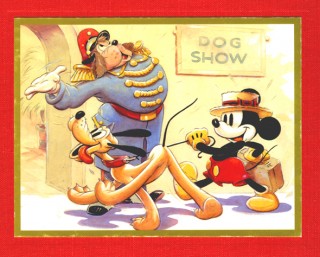 - From 1934 continuing into the late 1940′s, Good Houskeeping Magazine printed four-color full page previews of newly-released Disney shorts. These illustrations were, at first, painted by Tom Wood, and later by Hank Porter.
- From 1934 continuing into the late 1940′s, Good Houskeeping Magazine printed four-color full page previews of newly-released Disney shorts. These illustrations were, at first, painted by Tom Wood, and later by Hank Porter.
Here’s information from the book on Wood and Porter:
- Tom Wood came to Disney Studios in 1932 from his position as a Los Angeles daily newspaper artist. A quiet, hardworking individualist, he was well liked and highly regarded by those who knew him both personally and professionally. He worked at the Studio until his untimely death in 1940 and, as publicity artist, assumed primary responsibility for the monthly Good Housekeeping page as well as the creation of publicity stills for the theater. Since Good Housekeeping was the only magazine for which Disney produced these monthly watercolor sequences, we recognize their scarcity.
Wood typically worked on each of these pages for a full week. Beginning with sketchy, pencilled drawings which he would then ink himself, he also created the final watercolors which represented a 7-minutc Disney film short. Assisted by an “idea man” and a third person who wrote the story or dialogue, the publicity artist had the final approval on the finished version. After Wood’s death Hank Porter would continue working with the magazine well into the late 1940′s. Thereafter, production of these shorts was discontinued as costs became prohibitive and the Studio refused to compromise on quality.
The Alexander Gallery collected these illustrations in 1987 for an exhibition, and they published a book of them. Bill Peckmann has kindly loaned me his copy of the book, so I’ll post the illustrations over a number of posts.
Here are the first group of pages:
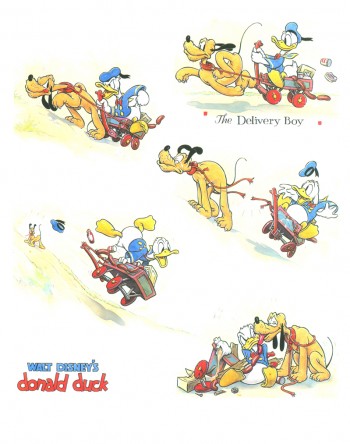 1
1
Donald Duck in “The Delivery Boy” 1938
(L) Donald Duck – Antarctic Troopers 1938
(R) Silly Symphony – The Practical Pig 1938
(L) Mickey Mouse – Society Dog Show 19389
(R) Goofy and Wilbur – Goofy and Wilbur 1939
Mickey Mouse – The Pointer 1939
(L) Donald Duck – Donald’s Date 1939
(R) Donald Duck – Officer Duck 1940
(L) Mickey Mouse – Ice Antics 1940
(R) Donald Duck – Donald’s Elephant 1940
Donald Duck – Billposters 1940
(L) Donald Duck – Donald’s Vacation 1940
(R) Donald Duck – Window Cleaners 1940
(L) Donald Duck – Fire Chief 1940
(R) Donald Duck – Put-Put Troubles 1940
(L) Mickey Mouse – The Little Whirlwind 1941
(R) Mickey Mouse – Big-Hearted Pluto 1941
Donald Duck – Timber 1941
Articles on Animation &Comic Art 23 Jul 2009 07:22 am
Keane Family Circus
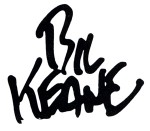 - I’ve had a bizarre attraction to Bil Keane‘s comic strip, The Family Circus. I was always sure that this strip might make a good animated show for television. In fact, A Family Circus Christmas directed by Al Kouzel was a good show. It came as a surprise when I first saw it, though there’s no reason I should have been. The story was first rate. The real surprise came years later when I learned that Bil’s son, Glen, had become one of the finest of the new-generation animators at Disney.
- I’ve had a bizarre attraction to Bil Keane‘s comic strip, The Family Circus. I was always sure that this strip might make a good animated show for television. In fact, A Family Circus Christmas directed by Al Kouzel was a good show. It came as a surprise when I first saw it, though there’s no reason I should have been. The story was first rate. The real surprise came years later when I learned that Bil’s son, Glen, had become one of the finest of the new-generation animators at Disney.
Bil Keane was interviewed in the Dec. 1975 issue of CARTOONIST PROfiles by the magazine’s editor, Jud Hurd, and I post it here:
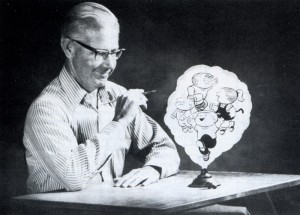 BIL KEANE is one of those fairly rare cartoonists who is just as funny on the speaking platform as he is onpaper in the two panels, THE FAMILY CIRCUS and CHANNEL CHUCKLES, he creates for THE REGISTER & TRIBUNE SYNDICATE. We heard another of Bil’s great talks again recent-ly, which prompted us to ask him some questions ahout cartooning for our magazine. BU and his famih- live in Paradise Valley, near Phoenix, Arizona.
BIL KEANE is one of those fairly rare cartoonists who is just as funny on the speaking platform as he is onpaper in the two panels, THE FAMILY CIRCUS and CHANNEL CHUCKLES, he creates for THE REGISTER & TRIBUNE SYNDICATE. We heard another of Bil’s great talks again recent-ly, which prompted us to ask him some questions ahout cartooning for our magazine. BU and his famih- live in Paradise Valley, near Phoenix, Arizona.
Q: Some time ago we did an interview with you that has caused a lot of comment. Your answers were hilariously funny, but not too informalive. l’d like this tobea serions interview that imparts to our readers the inner workings of Bil Keane.
KEANE: Fine. Which way to the X-ray machine?
Q: Seriously, could you give us a brief resumé of your art background?
KEANE: It’ll be quite brief because I never studied art. I taught myself to draw while I was in high school by imitating the cartoonists whose work I admired.
Q: Who were they?
KEANE: Each month I would have a different New Yorker magazine idol… George Price, Richard Decker, Peter Arno, Robert Day, Whitney Darrow, Barlow, Wortman… This was in the late thirties. l’d practice each style and technique until, in my mind, my drawings looked “similar” to the master. I still think this is an excellent way to develop a style. Eventually your own “thing” will emerge. I enjoyed studying cartoonists’ styles and learned to recognize them like handwriting. I used to play a game when Collier’s, The Saturday Evening Post, or American Magazine would arrive in the mail. As l’d turn a page on which there was a cartoon, l’d quickly cover the part of the cartoon bearing the signature and name the cartoonist who had made the drawing. Then, l’d lift my hand to see if I was right. I had a very high rate of accuracy. l’d be fooled only by a newcomer. I also became a fanatic cartoon clipper. I eut out every magazine cartoon I could find and pasted them in huge scrapbooks. I remember one time I was thrown out of a public library for slicing cartoons out of the current magazines with a razor blade. In fact, it was last week!
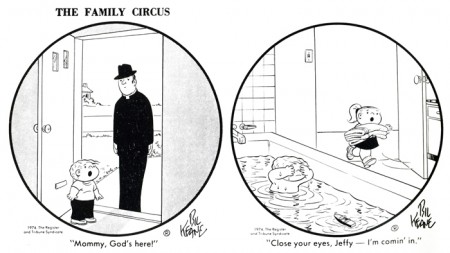
Q: Were magazine cartoons the only ones thaï interested you, or did you follow the newspaper cartoonists too?
KEANE: I never was an avid fan of the comic strip guys although I certainly admired most of the big ones. However, I had a real penchant for the newspaper panel cartoonists. George Lichty was my all-tirne favorite. I also liked H. T. Webster, Fontaine Fox, J. R. Williams, Gène Ahern and particularly Clare Briggs. Another genius to me was J. Norman Lynd who drew “Vignettes of Life.”
Q: Do you feel that most magazine gag cartoonists can develop a successful syndicated feature?
KEANE: Not necessarily. Some cartoonists are prolific and can turn out volumes of material from which a magazine editor may select the best. A syndicated cartoonist, for the most part, is his own editor. Unless he has the ability to discern which of his creations are good and which are poor, his feature will not hâve the batting average required to maintain success. I hâve seen highly successful magazine men fall fiât on their faces when attempting a 6 day a week feature done entirely by themselves.
Q: Some people write inspirations for cartoon ideas on the backs of old envelopes. Russell Myers carries a lape recorder and talks into it when he thinks of a “Broom Hilda” idea.
What system do you use for this?
KEANE: I don’t think of many “Broom Hilda” ideas, but when I do, I talk into the back of an old envelope.
Q: You promised this would he a serious interview.
KEANE: Frankly, for “Family Circus”, the only gimmick I use to think of ideas is thumbing through family type magazines where articles, pictures, ads, columns, etc., will suggest a setting or bring to mind one of the incidents that has happened in our home in the past. Given a specific setting or situation I can readily create a child’s reaction to it. I have a childish mind.
Q: Do you then write the caption or do the drawing first?
KEANE: It works both ways. Frequently the idea comes from a quote or phrase that is typical, or a youngster’s mispronounced word, or a childish musing such as: “Mommy, I need a hug.” Then all I do is create a cartoon that best fits with the line. At other times the picture depicts the identifiable scene such as a little girl dressed in her mother’s clothes, or a little boy running into the house with a bug in ajar, etc. Then I need to create a line to go with the illustration.
In most cases the caption is not really finalized till I am through with the drawing. As I am penciling the cartoon I keep saying the line over and over again to myself, changing it slightly to see how it sounds in various versions. I think it is terribly important in the kind of thing I do to have what a child says, or Mommy says, or whoever, sound natural, unmanufactured and clear.
Q: In “Channel Chuckles” you use a different type of humor than you do in “Family Circus.” Would you comment on this?
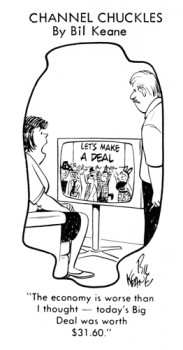 KEANE: “Channel Chuckles” humor is more satirical, zany and topical than “Family Circus.” The latter utilizes the identifiable, typical, “our kids have done the same thing” type of humor. Another entirely different field of humor that I like is the pun. I developed a solid background in this type of humor as a young boy when I was an avid collector of the old College Humor magazines that had been published in the 20′s and 30′s where piuis ran rampant. When I worked for the Philadelphia Bulletin in the late 40′s and during the 50′s I developed a Sunday color feature called “Mirth-quakers” which featured illustrated puns and the old “he-she” jokes (Sample: “Many big men born in this town?” “Nope, only little babies!”). For a few years, I drew a feature for the Saturday Evening Post “Pun-Abridged Dictionary. When my Sunday “Family Circus” page started in 1′ appended it with a weekly panel “Sideshow”, consisting of reader-contributed puns. The 25,000 letters a year that this feature drew, as well as the enthusiastic response other pun features convinced me that thi many pun-lovers in the country. (And quite few in the city, too, but they won’t admit it.)
KEANE: “Channel Chuckles” humor is more satirical, zany and topical than “Family Circus.” The latter utilizes the identifiable, typical, “our kids have done the same thing” type of humor. Another entirely different field of humor that I like is the pun. I developed a solid background in this type of humor as a young boy when I was an avid collector of the old College Humor magazines that had been published in the 20′s and 30′s where piuis ran rampant. When I worked for the Philadelphia Bulletin in the late 40′s and during the 50′s I developed a Sunday color feature called “Mirth-quakers” which featured illustrated puns and the old “he-she” jokes (Sample: “Many big men born in this town?” “Nope, only little babies!”). For a few years, I drew a feature for the Saturday Evening Post “Pun-Abridged Dictionary. When my Sunday “Family Circus” page started in 1′ appended it with a weekly panel “Sideshow”, consisting of reader-contributed puns. The 25,000 letters a year that this feature drew, as well as the enthusiastic response other pun features convinced me that thi many pun-lovers in the country. (And quite few in the city, too, but they won’t admit it.)
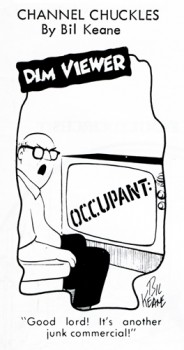 Q: You mentioned having worked for the Philadelphia Bulletin. Is this where you started and would you fill us in on your career to date?
Q: You mentioned having worked for the Philadelphia Bulletin. Is this where you started and would you fill us in on your career to date?
KEANE: My first job was or, Philadelphia Bulletin as a messenger in the year I graduated from high school. / years in the Army where I drew for Yank, Pacific Stars & Stripes, etc., I came back to the Bulletin with a fist full of my published service cartoons. This landed me a job in the news art department drawing spot cartoons and caricatures for the entertainment section which eventually led into my syndicate feature “Channel Chuckles” in 1954. I drew magazine cartoons for most of the markets, did a weekly Sunday comic for the Bulletin called “Silly Philly” (a little Quaker character based on William Penn), and edited a 16 page weekly supplement in the Sunday paper called “Fun Book”. When the income from “Channel Chuckles” and my free stuff enabled me to leave the 9 to 5 job at the Bulletin, my wife Thel (who I had met in Australia during the war and returned down under to marry in 1948) and I, along with our five small children moved to Paradise Valley, Arizona (near Phoenix) in 1959. Working at home for the first time with our little people underfoot, I discovered that most of the magazine cartoons I was selling had to do with family life and small children. I then decided to produce a second feature for the Register and Tribune Syndicate and introduced “Family Circus” in 1960.
Q: Wasn’t it originally called “Family CIRCLE”?
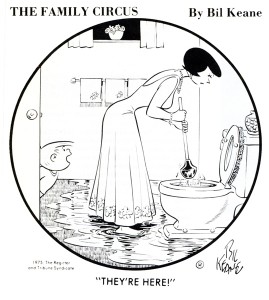 KEANE: Yes. I felt the name and circle format were a perfect combination. However, Family Circle Magazine (the one you read while waiting at the checkout counter in the supermarket) objected to the use of what they claimed to be their title and forced us to change the name of the feature. Frankly, I think if my syndicate had fought a small legal battle, we could have retained the CIRCLE title. The conversion was simple: I changed the last two letters from L-E to U-S. And, many feel that the CIRCUS title is more indicative of what goes on in the cartoon.
KEANE: Yes. I felt the name and circle format were a perfect combination. However, Family Circle Magazine (the one you read while waiting at the checkout counter in the supermarket) objected to the use of what they claimed to be their title and forced us to change the name of the feature. Frankly, I think if my syndicate had fought a small legal battle, we could have retained the CIRCLE title. The conversion was simple: I changed the last two letters from L-E to U-S. And, many feel that the CIRCUS title is more indicative of what goes on in the cartoon.
Q: Would you give us a rundown on your average working day?
KEANE: On most mornings I get up about 7:30, hit the studio (which overlooks the tennis court in case somebody wants to play) about 9, and work through most of the day with a break for lunch. It seems that the creative juices flow best late in the afternoon and will continue into the evening. I occasionally work after dinner till about 10 P.M. A comfortable couch in my studio is put to good use for 20 minute naps when 1 grow weary. Some mornings, especially in the summertime, I awaken about 4:30 A.M. and work till the morning Arizona sun is drenching Camelback Mountain with yellow. I then go back to bed (about 8 A. M.) for another hour of sleep. After breakfast I return to the studio to answer mail and to the more mechanical chores of drawing. It seems that the very early morning and early evening are the best times for uninhibited creative work. Of course, this work schedule varies around our social engagements and fairly frequent tennis matches. Totally, I average about 45 hours of real work each week and love every minute of it.
Q: An interviewer once asked you if “Family Circus” was based on your real life, and you replied that, on the contrary, your real life is based on the cartoon. If a particular situation gets a laugh in the feature, you try to work it into your home the following week. Bit, is that true?
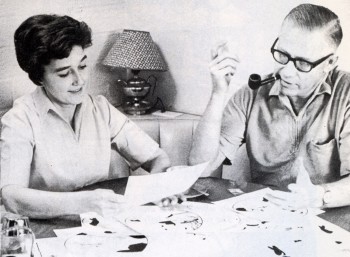 KEANE: No, but it’s a bit more amusing than the truth. My ideas are really based on our own family experiences and so are the characters. Our children aren’t as young as they once were, but, then who is? I have an excellent memory for detail and can recall vividly incidents from years ago. In fact, 1 even base a lot of the moods and childish attitudes in my cartoon on my own experiences as a small boy.
KEANE: No, but it’s a bit more amusing than the truth. My ideas are really based on our own family experiences and so are the characters. Our children aren’t as young as they once were, but, then who is? I have an excellent memory for detail and can recall vividly incidents from years ago. In fact, 1 even base a lot of the moods and childish attitudes in my cartoon on my own experiences as a small boy.
Bil and Thel review cartoons to submit.
Q: What are the ages of your five children now?
KEANE: The oldest is 25 and the youngest is 17. Glen, our 21 year old, is presently working in the animation department at Disney Productions in California.
Q: Do you get many cartoon ideas from reader mail?
KEANE: Well, not cartoon ideas per se. A young mother will occasionally write and say “Here’s something that happened in our house — maybe you can use it.” The incident she relates will form the nucleus of a situation to which I then apply my own family experience and whatever expertise I have as a gag creator. The result is usually a scene that took place in thousands of homes that very week. Basically, children never change and family life is universal and timeless.
Q: What advice would you give a young cartoonist aspiring to do a feature?
KEANE: I would highly recommend an art background. It is quicker in the long run than learning by your own mistakes. Also, stick to a subject with which you are familiar. This is the only way you will maintain high quality material. Don’t be a phony. Do what comes naturally.
Q: Obviously, since you live in Arizona, it has not been necessary for you to be close to the New York market to achieve success. Would you comment on this? KEANE: Even when I lived in Philadelphia I sold my cartoons to the Saturday Evening Post entirely through the mail and their offices were very close to the Bulletin Building where I worked. One of the beautiful things about this cartoon business is that it allows you to live anywhere there is a mailbox.
Q: How is your new cartoon book on tennis doing?
KEANE: It has only been out for a few months now, and already it’s selling into the dozens. Truthfully, the book (DEUCE AND DONTS OF TENNIS) is doing phenomenally well. Tennis is a popular subject and the $2.95 price is low enough to make it a hot item.
Q: What other books have you had published?
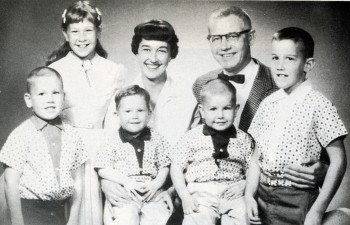 KEANE: Fawcett Gold Medal has published 12 paperback collections of my “Family Circus” cartoons. The newest, being released in October, is titled: “I CANT UNTIE MY SHOES!” The cover depicts Jeffy standing in a bathtub full of water. Several different publishing houses have put out books of my other cartoons. I collaborated with columnist Erma Bombeck on a book
KEANE: Fawcett Gold Medal has published 12 paperback collections of my “Family Circus” cartoons. The newest, being released in October, is titled: “I CANT UNTIE MY SHOES!” The cover depicts Jeffy standing in a bathtub full of water. Several different publishing houses have put out books of my other cartoons. I collaborated with columnist Erma Bombeck on a book
_________I believe that’s Glen to the far left._______________for Doubleday: “JUST WAIT TILL YOU HAVE CHILDREN OF YOUR OWN.” Erma is a neighbor and a genuinely funny lady.
Q: Not many cartoonists are funny on their feet as well as on paper. You have quite a reputation as a stand-up comedian delivering side-splitting talks at a microphone. Is this a natural talent or something you learned?
KEANE: It’s another thing I’ve taught myself through the years. I love to make people laugh and just eat up the immediate crowd reaction and applause, which is a pleasant change from drawing a cartoon and waiting weeks or months till after it is published for any reaction. When I give a talk, I write every word in advance. I plan the comments and one-liners carefully, making the material as topical and intimate as possible for that audience. In addition to concise, fresh material, the two important things for a stand-up comedian are delivery and timing. While giving speeches can be profitable, it is terribly time-consuming. I limit my personal appearances to only the ones I really want to do.
Q: Thanks, Bit. Do you have a final word?
KEANE: Yes — ZYZZOGETON. It’s on the last page of my dictionary. Before I close, Jud, I would like to say something nice about CARTOONIST PROfiles. I’d like to, but I can’t think of anything. Seriously, folks — your publication is an excellent chronicle of every phase of cartooning. We have all learned a lot about each other through your meticulous efforts. You deserve a big round of applause. (Jud gets a sitting ovation.) A hundred years from now people will be talking about Jud Hurd — which will give you an idea of how dull things are going to be in a hundred years.

Bill, Thel and Paradise Valley.
Books &Comic Art &Disney &Illustration 09 Oct 2008 08:23 am
Wise Little Hen – Book
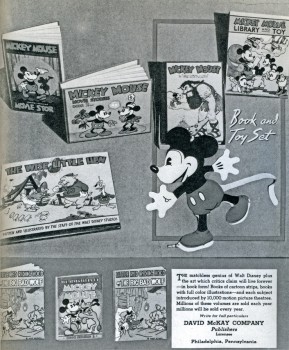 - Another gem from the collection of John Canemaker is this early book published by Whitman in 1935. The Silly Symphony short, The Wise Little Hen, introduced Donald Duck to the world on release of the film in 1934.
- Another gem from the collection of John Canemaker is this early book published by Whitman in 1935. The Silly Symphony short, The Wise Little Hen, introduced Donald Duck to the world on release of the film in 1934.
The book is a good example of some early merchandising by the Disney brothers. These books started out as Premium give-aways: for example Mickey Mouse, Mail Pilot was given away by the American Oil Company and Mickey Mouse Sails for Treasure Island was a premium for Kolynos Dental Cream.
The success of the books continued for many years, even after Whitman grew into the Western Publishing who released the Little Golden Books and many many comic books featuring Disney characters. _____________________________An early ad for the books.
Here are the illustrations for this book:
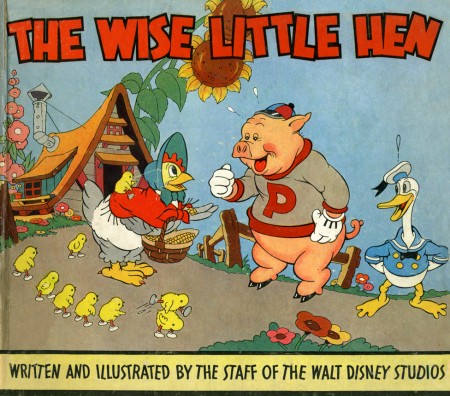
(Click any image to enlarge.)
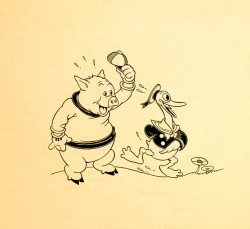
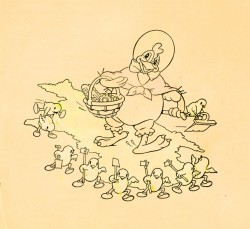
These two images greet you when you open the book.
They’re the inner cover for both the front and back of the book.
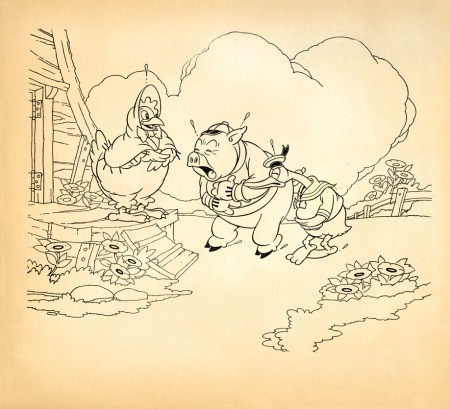
I wish Donald had continued to look like this. I love the way he looks in the film.
Animation Artifacts &Comic Art &Daily post 08 Oct 2008 08:23 am
Van Boring
- I received an email yesterday from Tom Sito (who’d heard it from Jeff Massie) that Gerard Salvio died June 23 at the age of 82. Gerard was the last Business Agent for Local 841 of the NY chapter of the Screen Cartoonists Guild. He and I bumped heads quite a few times during the production of Raggedy Ann, but we always did it with civility and good temper. After that feature, the Guild slowly fell in NY, eventually becoming part of another union.
Tom’s note points out that there’s an obituary on page 70 of the latest IATSE Bulletin (which I don’t have). This obit appeared in the NY Daily News: Gerard R. SALVIO, June 20, 1926 – June 23, 2008. Of complications from renal failure. Optical Cameraman for MPO & EUE; Business Agent, Screen Cartoonists Local 841, IATSE & later IATSE Int’l Rep. Gerard is survived by his wife, Ann Salvio, (nee Terpay); his daughters, Katherine Salvio, Lenore Hinrichsen, Janet Littlejohn & his granddaughters Danielle Hinrichsen & Sara Littlejohn.
Jeff Massie also pointed to this book about Gerard written by one of his daughters.
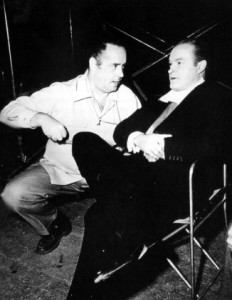 - Allan Holtz’ Stripper’s Guide, a site featuring lots of interesting information and examples of past comic strips, has a post highlighting the Van Boring strip done by “Tish Tash,” otherwise known as Frank Tashlin. Of course, he was the man who directed Scrap Happy Daffy and The Disorderly Orderly as well as plenty of other animated and non-animated films. Tashlin also did a short-lived comic strip. Obscure examples are on display at this site.
- Allan Holtz’ Stripper’s Guide, a site featuring lots of interesting information and examples of past comic strips, has a post highlighting the Van Boring strip done by “Tish Tash,” otherwise known as Frank Tashlin. Of course, he was the man who directed Scrap Happy Daffy and The Disorderly Orderly as well as plenty of other animated and non-animated films. Tashlin also did a short-lived comic strip. Obscure examples are on display at this site.
There’s also a follow-up post on Scott Marks’ Emulsion Compulsion.
There’s an excellent interview with Tashlin (and another example of Van Boring) on Mike Barrier‘s site – naturally enough.
If you’d like to know more about Tashlin (and you should) look at this NYTimes article._______Tashlin & Bob Hope “The Lemon Drop Kidâ€
And speaking of Mike Barrier, if you haven’t read his piece on Phil Klein, check it out. There’s a wealth of material there, and it flows so effortlessly for Mike. (Or, at least, it seems that way.) I have to say I love this site.
 Another site I love is A Film LA, Hans Perk‘s gem. So much material shows up there. Recently he had an ad I remembered from the ’50s. It took me by surprise. It advertised for the Disney Animation Kit available from Disneyland’s Art Corner.
Another site I love is A Film LA, Hans Perk‘s gem. So much material shows up there. Recently he had an ad I remembered from the ’50s. It took me by surprise. It advertised for the Disney Animation Kit available from Disneyland’s Art Corner.
I actually bought one of those kits and animated on the light box for many years after making almost two hours of 8mm animation before I even got to college. Lots of memories in that one ad.
The kit included books on how to draw Mickey, Donald, Goofy and Pluto. It also had a book on tips on animating (stretch & squash, follow through, etc.) I lost those books but got copies of them when Disney held a big event at NY’s Lincoln Center in 1973. The set also included a lightbox – a wedge you constructed made of beaver board with three holes to place three circular wooden pegs into it. They gave a couple of flip books and a couple of exposure sheets. That kit probably solidified my desperate desire to get into animation when I was a kid. Is there anything comparable today to inspire children?
Then, to top off that post, Hans has given us the scene drafts to The Alpine Climbers, a brilliant Mickey short. This site is probably the equivalent, at least for me, of the Art Corner at Disneyland.
You can see a closer look at at the Animation Kit on Jenny Lerew’s site, Blackwing Diaries, where she also displays a couple of the books.
Animation Artifacts &Comic Art &Commentary 16 Aug 2008 07:58 am
Odds and More Ends
Today’s NY Times features a Blog/Article that analyzes all of the Star Wars movies. The author, Chris Suellentrop, says the new video game is “small consolation for the realization that the franchise that dominated their lives for 30 years has ceased to matter.”
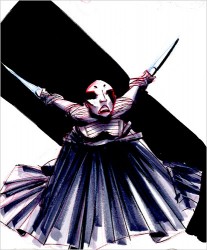 Lucas’ Cloned Wars received one star
Lucas’ Cloned Wars received one star ![]() from all of the NY papers, including the NY Daily News. JOE NEUMAIER says of the film, it’s “chock-full of video game-style action scenes and drawn to resemble the puppets in the 1960s British TV show “Thunderbirds,” is just as wooden as the last few live-action movies…”
from all of the NY papers, including the NY Daily News. JOE NEUMAIER says of the film, it’s “chock-full of video game-style action scenes and drawn to resemble the puppets in the 1960s British TV show “Thunderbirds,” is just as wooden as the last few live-action movies…”
NATHAN LEE in the NY Times says: “it isn’t the most painful movie of the year!”
The NY Times also has a slide show feature of “concept art” from the film (five images.) That’s where I pulled the image to the left.
Newsday‘s RAFER GUZMÃN (AP) says: “the film feels like an unauthorized knock-off, one of those “tribute” shorts that pop up on fan Web sites.”
Apparently this is the pilot for a new series coming to Cartoon Network. It’s obviously part of their push to get more 14 year old boys to watch. I guess it’s a positive that it’s not a live action series for CN. I wonder how long it will be before Lukas clones “Indiana Jones”?
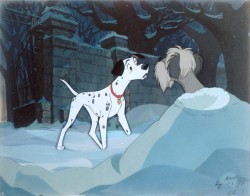 – Mark Mayerson, as you probably know, still continues to post his wonderful Mosaics on 101 Dalmatians and gives the excellent commentary with it. I write this only to remind you to keep up. Mark’s work is an enormous resource that can be too easily taken for granted. I wish he were able to print these up in book form. Perhaps, some day Disney books will realize there’s an excellent publication for grab here. “?
– Mark Mayerson, as you probably know, still continues to post his wonderful Mosaics on 101 Dalmatians and gives the excellent commentary with it. I write this only to remind you to keep up. Mark’s work is an enormous resource that can be too easily taken for granted. I wish he were able to print these up in book form. Perhaps, some day Disney books will realize there’s an excellent publication for grab here. “?
- Robert Cowan‘s art collection includes a cel set-up (above left) that seems to jump right off Mark’s mosaic. How interesting that Mark chose that particular set-up. How great the Cowan collection is; take a look at the site if you’re not familiar with it or if you haven’t been there in a while. You should also look at his Comic Art collection. There, you’ll find everything from Burne Hogarth to George MacManus to Winsor McCay.
- On the Animation Archive site, I found these Bg. plans for 101 Dalmatians. It really defines the layout of the house. In case you don’t know this site, they have dozens of model sheets for viewing. Some are brilliant, some are bad copies, all are worth checking out.
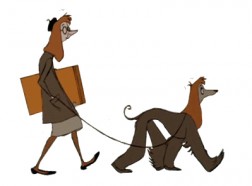
- I received an interesting art link yesterday which displays accredited art colleges to create a comprehensive directory for potential students to browse. Since I’m sure a lot of students check out this blog, I thought it might be a useful link for some readers out there. It’s called FindYourArtSchool.com.
For those considering an education in fields relevant to animation, this may be helpful.
.
Comic Art &repeated posts 14 Jun 2008 08:25 am
RecapSat: The Toonerville Trolley
_____This is a recap of a post I did in June 2006 though I added more strips
_______________to the end of the piece.
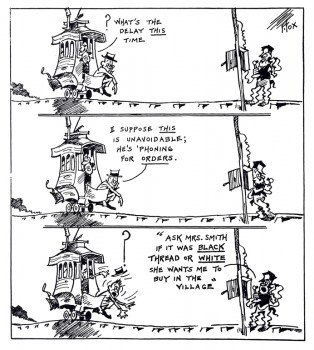 - I’ve been a big fan of the “Toonerville Folks” for a long time. I didn’t find the strip for a while. When I was young, a local TV channel, an ABC subsidiary, ran a lot of old silent Aesop’s Fables. They had classical music backing them up; usually Bizet filled the bill.
- I’ve been a big fan of the “Toonerville Folks” for a long time. I didn’t find the strip for a while. When I was young, a local TV channel, an ABC subsidiary, ran a lot of old silent Aesop’s Fables. They had classical music backing them up; usually Bizet filled the bill.
One year they upgraded by throwing a number of the Van Buren shorts in betwen the Terry silent films.
These Van Buren films, many of them directed by Burt Gillette or Tom Palmer, were odd. There were a number of films with Greek gods as their stars. Then came the shorts with Molly Moo Cow and those with the Toonerville Trolley characters.
I liked these and learned from the credits that they were adapted from a comic strip by Fontaine Fox. So, I sought out the comic. Of course, in those days, prior to computers, all you had was the library to research things. My local branch had only one or two examples of the comic strip which ran from 1915 through 1955.
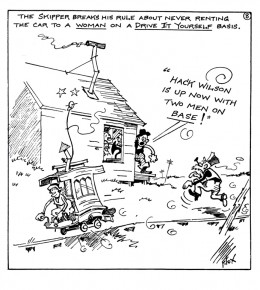

The animated shorts were made in the mid-thirties when Van Buren tried a run to improve their films. Neither sound and color nor the acquisition of the rights to this strip didn’t help; even the “terrible tempered Mr. Bang couldn’t help.” The studio closed before the decade had ended.
In 1978 I worked with R.O. Blechman as his Assistant Director to put together the PBS show, Simple Gifts. This was a packaged of six segments adapted around Christmas with a number of different illustrators designing the segments. One of them, the one I was most attracted to was The Toonerville Trolley. Blechman bought the rights from King Features (at an enormous price) for a four minute film in the middle of the program. I’d worked hard to get the piece to animate. I even did a one minute sample of the film in my off time at night, and I thought it was pretty good. However, Blechman was afraid of losing me in the operation of his studio. (We were doing more commercials than show, and I hated it.) Bill Littlejohn did a nice job of animating the entire piece which was completely subcontracted out to him. That was probably appropriate since Bill worked at Van Buren when they produced these shorts.
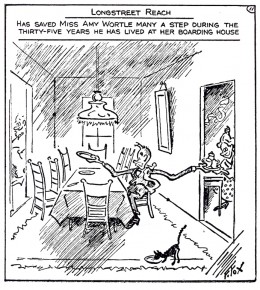
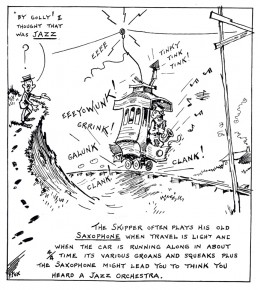
__________(Click any image to enlarge.)
